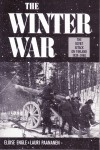The Winter War by Elise Engle and Lauri Pannanen (1973. Stackpole Books. ISBN 978-0-8117-2433-3)
In the process of researching and writing my new novel about Finland, Karelia, Estonia, and the United States between the Great Depression and the Second World War, I have been reading quite a few very well written books from foreign authors on these topics (all translated into English, of course!). This slender non-fiction account of the Soviet Union’s unprovoked attack on neutral Finland (the country had allied itself with Sweden and Norway and did not want to be dragged into the war) in November of 1939, is a great place to begin your understanding of the Winter War and what the Finns were able to accomplish against a much larger and better equipped aggressor. I had the misunderstanding (as I am sure most non-Finns do) that the Winter War, a defensive struggle that preserved Finland’s independence, was cheered as a victory by the Finns. I was wrong in my perception: The authors of this exhaustively detailed account of the causes for the war, the battles, the personages, the tactics, and the end result make it clear that Finns of the time did not consider the Winter War to be a success. By the time of armistice, nearly 450,000 Finns in Karelia were given this unattractive choice: Stay in your homes and on your farms and become Soviet citizens or leave everything behind and move to Finland. Unanimously, the Finns of Karelia moved, a circumstance which, along with the territory, resources, reparations, and infrastructure Finland handed over to Stalin left a bitter, bitter taste in the nation’s mouth.
At times, the writing in the book seems to migrate towards memoir or even fiction by bringing first-person and third-person narratives into an otherwise fairly clinical and scholarly work. It’s as if the authors couldn’t decide whether to write a more detailed and less poetic version of Antiti Turri’s novel of the same name (The Winter War. 2003. Aspasia Books. ISBN 978-0-973-1-5339) or stick to the facts. Such diversions can be, when an author is looking to the volume in front of him or her as a reference, a bit disconcerting. What is truth? What is embellishment? But, in this book, this problem is minimally distracting and doesn’t impact, in my view, the overall veracity of the work.
Of great help to me in understanding the conflict were the battle maps and photos.
A very fine resource regarding a fairly obscure topic.
4 stars out of 5.



